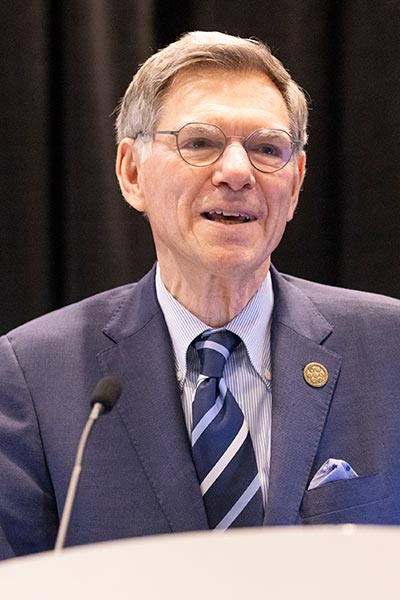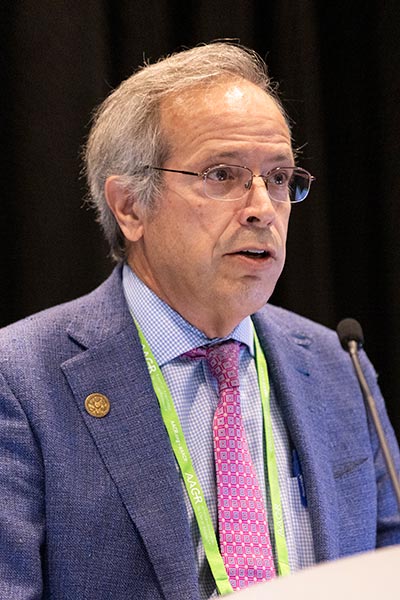Margaret Foti Award recipient reflects on accomplishments in both academia and industry

Among the career highlights of William “Bill” N. Hait, MD, PhD, FAACR, one that stands out is his work as the founding director of the Rutgers Cancer Institute, the first and still only National Cancer Institute (NCI)-designated Comprehensive Cancer Center in New Jersey.

“Bill was the fifth person hired and nine years later he had a fully comprehensive … cancer center,” said Michael A. Caligiuri, MD, FAACR, Immediate Past President of City of Hope National Medical Center and the Treasurer and Past President of the American Association for Cancer Research (AACR). “It was just an extraordinary accomplishment, just amazing.”
Hait, this year’s winner of the AACR-Margaret Foti Award for Leadership and Extraordinary Achievements in Cancer Research, had noticed the need for advanced cancer care in New Jersey after his mother received an ovarian cancer diagnosis. “I could not find a hospital in New Jersey at the time that had the level of sophistication that could provide the care that she needed,” he told attendees of his award lecture From Academia to Industry: An Incredible Journey in Innovation at the AACR Annual Meeting 2025.
During this period, Hait received a phone call to explore launching a cancer center in New Jersey. He was reluctant to leave his well-established lab at Yale, but they were persistent. “I thought of all the people in New Jersey who could potentially benefit if we could pull it off and develop an NCI-designated Comprehensive Cancer Center of that quality that could take care of patients like my mom,” he said.
Fourteen years later, it was time for a new challenge. Industry beckoned, but a meeting with a prominent recruiter proved disappointing, said Hait. “He says, ‘You have a great record, but you’re too old at 58 to go into the pharmaceutical industry.’”
In 2007, Hait joined Johnson & Johnson. He stayed for 17 years, eventually rising to executive vice president, chief external innovation and medical officer, at the time of his 2024 retirement. “As head of R&D, I had about 10,000 people in my group. We used [our] money wisely and developed 20 new products, most of them first in class, many of them oncology drugs helped by people in this audience,” he said. “It was fantastic, the feeling that you’re helping millions of patients.”
Hait reflected on some of the key differences between academia and industry, noting that, due to his long academic career, he was eligible for equally senior corporate positions not available to newer scientists. “You’re going to hear about entry-level positions that may not sound that great at first, but remember, once you get inside, you have an opportunity to learn and to move across and move up,” he said. “You can learn regulatory, you can learn all sorts of things in addition to R&D, [but] getting in is the key.”
Hait, a former Treasurer and Past President of the AACR and the recently named Chief Scientific Advisor, noted that performance evaluation standards differ between academia and industry, with academia focusing largely on individual accomplishments. “In industry, it’s about the team,” he said. “Success drives a lot of your evaluation, so you could be doing a great job, but if the product fails early or your project doesn’t go anywhere, that’s going to impact your evaluation even if you’re doing fantastic work yourself.”
Hait also addressed what he called the misperception that the quality of science in industry is poor. “I think it’s just the opposite. In industry, your experiments are carefully evaluated [because] if the results aren’t good and they’re not reproducible, the project’s not going to move along,” he said. “In addition, the clinical trial design is more rigorous than I ever experienced in academia because there are hordes in a big pharmaceutical company of clinical trial experts and excellent statisticians who help you design trials appropriately.”
Hait reflected on what it’s like to work so closely with the FDA. “[In industry], you’re answering to the FDA and other regulatory agencies, and I can tell you they don’t miss a thing,” he said. “They review all the data, your tox data, your animal data, your raw data,” he said. “Now in academia, you self-select the results you send to reviewers, publications, and your grants, and they’re not seeing your raw data.”
Additionally, the workload is not lighter in industry than in academia. “[It’s] much harder in industry because you’re on very strict timelines,” he said. “You’re under tremendous time pressure to deliver, and you are constantly being harangued by project managers [to make sure you] hit these timelines.”
The pace in industry is unrelenting, too. “I used to take the month of August off when I was in academics,” Hait said. “Believe me, that wasn’t happening at J&J.”
Despite these challenges, Hait urged younger scientists to consider a career in industry. “Go in with [your] eyes wide open, pursue the opportunity with passion and commitment, and the rewards will be much greater than financial,” he said. “A new drug approval to meet an unmet medical need is a life-changing event for patients, physicians, and for the scientists who made it happen.”
The recording of the full session is available for registered Annual Meeting attendees through October 2025 on the virtual meeting platform.
More from the AACR Annual Meeting 2025
View a photo gallery of scenes from Chicago, continue the conversation on social media using the hashtag #AACR25, and read more coverage in AACR Annual Meeting News.

